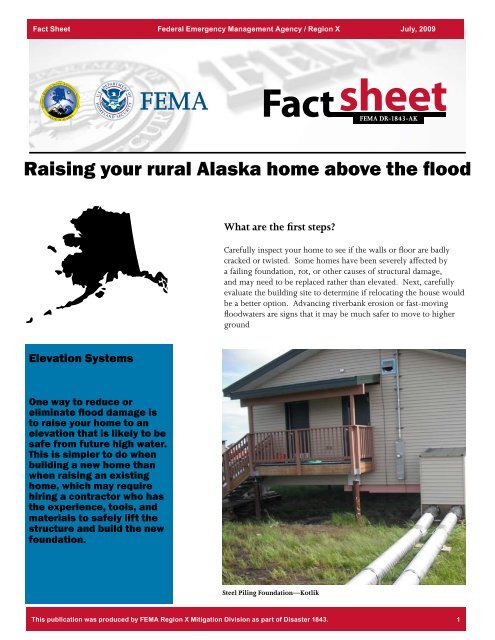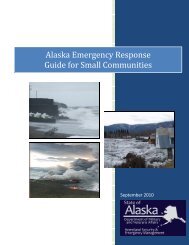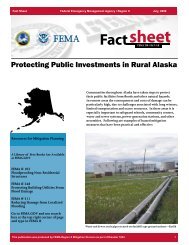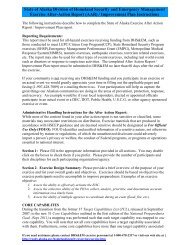Rural Home Flood Elevation Fact Sheet - Alaska Division of ...
Rural Home Flood Elevation Fact Sheet - Alaska Division of ...
Rural Home Flood Elevation Fact Sheet - Alaska Division of ...
You also want an ePaper? Increase the reach of your titles
YUMPU automatically turns print PDFs into web optimized ePapers that Google loves.
<strong>Fact</strong> <strong>Sheet</strong> Federal Emergency Management Agency / Region X July, 2009<br />
<strong>Fact</strong><br />
FEMA<br />
sheet<br />
DR-1843-AK<br />
Raising your rural <strong>Alaska</strong> home above the flood<br />
What are the first steps<br />
Carefully inspect your home to see if the walls or floor are badly<br />
cracked or twisted. Some homes have been severely affected by<br />
a failing foundation, rot, or other causes <strong>of</strong> structural damage,<br />
and may need to be replaced rather than elevated. Next, carefully<br />
evaluate the building site to determine if relocating the house would<br />
be a better option. Advancing riverbank erosion or fast-moving<br />
floodwaters are signs that it may be much safer to move to higher<br />
ground<br />
<strong>Elevation</strong> Systems<br />
One way to reduce or<br />
eliminate flood damage is<br />
to raise your home to an<br />
elevation that is likely to be<br />
safe from future high water.<br />
This is simpler to do when<br />
building a new home than<br />
when raising an existing<br />
home, which may require<br />
hiring a contractor who has<br />
the experience, tools, and<br />
materials to safely lift the<br />
structure and build the new<br />
foundation.<br />
Steel Piling Foundation—Kotlik<br />
This publication was produced by FEMA Region X Mitigation <strong>Division</strong> as part <strong>of</strong> Disaster 1843. 1
<strong>Fact</strong> <strong>Sheet</strong> Federal Emergency Management Agency / Region X July, 2009<br />
How high should you raise your home<br />
If it makes sense to elevate your home, take care to plan for an adequate level <strong>of</strong> protection. Future flood levels are<br />
impossible to predict with accuracy so plan your project so that the floor will be at or above the recommended building<br />
level for your area (if that has been established), or at least two feet above the highest previous flood level in your area. The<br />
exact locations <strong>of</strong> ice jams are nearly impossible to predict and can sometimes cause unusually high flooding.<br />
Wood foundation system—Akiak<br />
Steel piling foundation system—Kotlik<br />
How will your house be supported<br />
The open frame work <strong>of</strong> the elevated foundation systems commonly used in <strong>Alaska</strong> allows floodwaters to pass freely<br />
beneath the building. In many rural areas <strong>of</strong> <strong>Alaska</strong>, wood pilings or posts are commonly used. Adjustable steel framework<br />
systems and steel piling foundations are expensive, but very durable alternatives.<br />
In some areas, building on a gravel mound can help prevent both flooding <strong>of</strong> a home and foundation settlement problems.<br />
This requires a source <strong>of</strong> gravel and hauling equipment, and is not recommended at sites that are subject to erosion by fastmoving<br />
floodwaters<br />
Triodedic foundation system—Shishmaref<br />
House elevated on gravel mound—Tanana<br />
Build Stronger, Safer, Smarter 2








